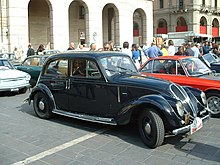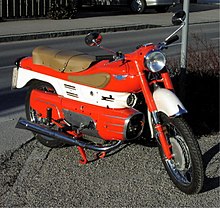Mario Revelli di Beaumont
Mario Revelli di Beaumont (born June 25, 1907 in Rome , † May 29, 1985 in Grugliasco ) was an Italian motorcycle racer and vehicle designer .
Life
Mario Revelli di Beaumont came from an old Piedmontese noble family and was interested in mechanics from his father Abiel Bethel Revelli di Beaumont, who was an officer in the Esercito Italiano and a designer of automatic firearms .
From 1922 he attended the Scuola Militare Nunziatella in Naples . At the same time, spurred on by his brother Gino, who owned a motorcycle shop in Turin, he began to develop chassis for motorcycles and to test them in races. With the GR 500 , the two brothers built a racing motorcycle that was equipped with a 500 cc JAP built -in engine and, with Mario Revelli di Beaumont, on September 13, 1925, at the age of only 18, the IVth Grand Prix of Nations won at the Circuito di Milano . As the 1925 European motorcycle championship title was also awarded at this Grand Prix , he was crowned half-liter European champion ahead of his compatriots Pietro Ghersi ( Moto Guzzi ) and Mario Saetti ( Norton ).
After completing his studies in Naples, Mario Revelli di Beaumont began working for Stabilimenti Farina in Turin , where he played a key role in the design of several luxury automobiles from Isotta Fraschini and the Fiat 525 . Soon he was also working for other large coachbuilders of his time such as Garavini or the Carrozzeria Ghia . The Italian started working for Fiat in 1929 . Here, too, he primarily devoted himself to the design of luxury and sports car models, but also worked on some cheaper models. He also designed interior fittings for aircraft for Fiat Aviazione . During this time he also began working on a project for a van , which Fiat ended after a while and only implemented around 20 years later.
Pininfarina was founded in 1930 and Revelli di Beaumont began working for Battista Pininfarina in parallel with his commitment to Fiat . In 1935 he was responsible for the very innovative design of the Fiat 6C 1500 , supported by patron Giovanni Agnelli . In the mid-1930s, he also designed some sporty models for Fiat. In the second half of the 1930s, he mainly worked with Pininfarina and the Carrozzeria Viotti . At this time, curved and particularly aerodynamic lines were modern in European automobile design. Revelli di Beaumont subsequently became Italy's greatest exponent of this style, which became known under the French term flamboyant . At the same time, he was also doing research on a small car with an electric drive.
With the outbreak of World War II , the Italian automotive industry increasingly shifted to the development of military vehicles . During this time, Mario Revelli di Beaumont worked mainly for Viotti on converting the Fiat 1100 into ambulances and light trucks . Towards the end of the war, because he belonged to the nobility and was therefore suspected of being a monarchist , he was arrested by the Germans and later freed by partisans of the Resistancea .
After the war, Revelli di Beaumont worked again for Pininfarina, Fiat, Siata and Viotti. At Viotti, he continued his activities during the war and in 1946 created the ancestor of the modern station wagon with the 1100 Fiat Viotti Giardinetta . In 1952 Revelli di Beaumont went to the USA , where he worked on the development of a city car for General Motors . In 1954 he returned to Italy and began to work for the French manufacturer Simca , where he drew some special bodies for the Simca 8 and the Aronde and had a particularly great influence on the design of the Simca 1000 and Simca 1300 . He later worked for the Italian motorcycle manufacturer Aermacchi , for whom he designed the futuristic but unsuccessful Chimera model , which was presented at the Salone di Milano in 1956 .
From 1963 Mario Revelli di Beaumont worked again for Pininfarina, but also advised companies overseas . The Italian later taught at the Scuola d'Arte e Design in Turin and the Art Center College of Design in Pasadena, California .
Mario Revelli di Beaumont died on May 29, 1985 at the age of 77.
title
- 1925 - 500 cm³ European champion on GR- JAP
References
Web links
- Grugliascocelebra il designer Mario Revelli di Beaumont. www.repubblica.it, April 11, 2008, accessed December 31, 2012 (Italian).
Individual evidence
- ↑ Vincent Glon: L'Histoire de la course moto - Palmarès des Championnats d'Europe (1924-1937 et 1947-1948). racingmemo.free.fr, accessed on December 29, 2012 (French).
- ↑ Vincent Glon: L'Histoire de la course moto; 5th partie: Les Grand Prix d'Europe. (1924-1937); 1925. racingmemo.free, accessed December 29, 2012 (French).
- ↑ Alessandro Sannia: Enciclopedia dei carrozzieri italiani , Società Editrice Il Cammello, Torino, 2017, ISBN 978-8896796412 , p. 256.
| personal data | |
|---|---|
| SURNAME | Revelli di Beaumont, Mario |
| BRIEF DESCRIPTION | Italian motorcycle racer and vehicle designer |
| DATE OF BIRTH | June 25, 1907 |
| PLACE OF BIRTH | Rome |
| DATE OF DEATH | May 29, 1985 |
| Place of death | Grugliasco |



